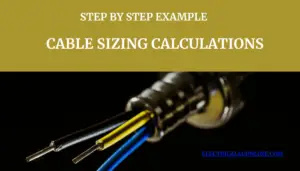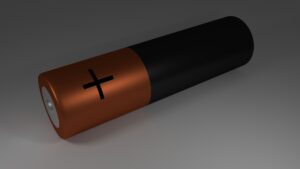3 Phase Power Formula, P =√3* V * I * pf, While 1 Phase Power Formula, P = V * I * pf, Every day, the power formula is being used to calculate the power of various load types like motors, lighting, and much more.
In this article, I will share with you how we calculate power step by step, and below I provide a power calculator.
Table of Contents
3 phase power formula
The formula for calculating the power in a three-phase electrical circuit is:
P=√3×VL×IL×cos(θ)
Where:
- is the power in watts (W).
- √3 is the square root of 3, approximately 1.732
- is the line-to-line voltage in volts (V).
- is the line current in amperes (A).
- is the power factor (cosine of the phase angle difference between voltage and current).
This formula takes into account the fact that in a three-phase system, the power is not simply the product of the line-to-line voltage () and line current (), as it would be in a single-phase system.
Instead, you need to multiply by the square root of 3 and the power factor () to get the true power in the circuit.
The power factor () represents the phase angle difference between the voltage and current waveforms and can vary depending on the type of load connected to the three-phase circuit. It indicates how effectively electrical power is being converted into useful work.
A power factor of 1 (cosine of 0 degrees) represents a purely resistive load, while a power factor less than 1 indicates a combination of resistive and reactive components in the load.
3-phase power calculation example
Let’s go through an example of 3-phase load calculation step by step.
Example: Suppose you have a three-phase electrical system with the following parameters:
- Line-to-line voltage (): 400 volts.
- Line current (): 50 amperes.
- Power factor (): 0.9 (lagging power factor, which means the current lags behind the voltage).
We want to calculate the power () in watts (W).
Step 1: Write down the given values.
- Line-to-line voltage (): 400 V
- Line current (): 50 A
- Power factor (): 0.9
Step 2: Calculate the power () using the formula with 1.73
Now, you can use the three-phase power formula with 1.73 instead of √3:
P=1.73×VL×IL×cos(θ)
Plug in the values:
P=1.73×400 V×50 A×0.9
P
So, the power in the three-phase electrical system is approximately 69,570 watts.
ingle phase power formula
The formula for calculating single-phase power in an electrical circuit is:
P=V×I×cos(θ)
Where:
- P is the power in watts (W).
- is the voltage in volts (V).
- I is the current in amperes (A).
- is the power factor, which is the cosine of the phase angle difference between voltage and current.
This formula calculates the real power (in watts) in a single-phase circuit. The power factor (cos(θ)) represents the phase angle difference between voltage and current and indicates how effectively electrical power is being converted into useful work.
A power factor of 1 (cosine of 0 degrees) represents a purely resistive load, while a power factor less than 1 indicates a combination of resistive and reactive components in the load.
To calculate the power in a single-phase system, you need to know the voltage, current, and power factor of the circuit.
single phase power calculation example
Let’s walk through an example of calculating single-phase power step by step.
Example: Suppose you have a single-phase electrical circuit with the following parameters:
- Voltage (): 120 volts.
- Current (): 5 amperes.
- Power factor (): 0.9 (lagging power factor, which means the current lags behind the voltage).
We want to calculate the power () in watts (W).
Step 1: Write down the given values.
- Voltage (V): 120 V
- Current (I): 5 A
- Power factor (): 0.9
Step 2: Calculate the power (P) using the formula.
Now, you can use the single-phase power formula:
P=V×I×cos(θ)
Plug in the values:
P=120 V×5 A×0.9
Step 3: Calculate the power ().
Now, calculate the power:
P=120 V×5 A×0.9=540 W
So, the power in the single-phase electrical circuit is 540 watts.
In this example, we used the given voltage, current, and power factor to calculate the real power (in watts) in the single-phase circuit.
dC power formula
The formula for calculating DC (direct current) electrical power is straightforward:
P=V×I
Where:
- represents power in watts (W).
- is the voltage in volts (V).
- I is the current in amperes (A).
In DC circuits, power is simply the product of voltage and current. This formula holds true for any DC electrical system, whether it’s a battery-powered device, a DC power supply, or any other DC circuit.
To calculate the DC power, you need to know both the voltage and current values. Once you have these values, you can use the formula to determine the power consumption or power delivery in the DC circuit.
dC power formula example
Let’s walk through an example of calculating DC (direct current) power using the formula:
Example: Suppose you have a simple DC circuit with the following parameters:
- Voltage (): 12 volts.
- Current (): 5 amperes.
You want to calculate the power () consumed by this DC circuit.
Step 1: Write down the given values.
- Voltage (): 12 V
- Current (I): 5 A
Step 2: Use the DC power formula.
Now, you can use the formula for DC power:
P=V×I
Step 3: Calculate the power ().
Plug in the values:
P=12 V×5 A
Step 4: Calculate the power ().
Now, calculate the power:
P=60 W
So, the power consumed by the DC circuit is 60 watts.
In this example, we used the given voltage and current values to calculate the power in the DC circuit.
The formula P=V×I is simple and effective for determining DC power consumption or power delivery in various electrical devices and circuits.
Install my Free Android App on Google Play:
Electrical Cables Most Common Tables “Electrical Cables Tables”
And, my Electrical Calculations App “Fast Electrical Calculator”
Discover more great content by subscribing to My channel
Looking to stay ahead of the game in the world of electrical engineering? Subscribe to my YouTube channel and gain access to exclusive content you won’t find anywhere else!
The staff I recommend
(Amazon Affiliate Links to products I believe are high quality):
- Economy 120 Volt/60Hz AC Power Source – Step-Down Voltage & Frequency Converters 1800W
- UNI-T Digital Multimeter Tester UT139C
- 50-Amp Extension Cord for RV “100ft”
- Voltage Stabilizer 110/220v
- Hair Dryer “best selling“
- TOSHIBA EM131A5C-BS Countertop Microwave Ovens
Disclaimer: This contains affiliate links to Amazon products. I may earn a commission for purchases made through these links.



